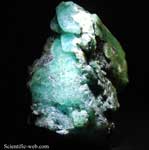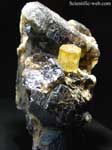| - Art Gallery - |
The mineral beryl is a beryllium aluminium cyclosilicate with the chemical formula Be3Al2(SiO3)6. The hexagonal crystals of beryl may be very small or range to several meters in size. Terminated crystals are relatively rare. Pure beryl is colorless, but it is frequently tinted by impurities; possible colors are green, blue, yellow, red, and white. Etymology The name Beryl is derived (via Latin: Beryllus and Old French: beryl) from Greek βήρυλλος "Beryllos" which referred to a precious blue-green color-of-sea-water stone[1] and originated from Prakrit veruliya (वॆरुलिय) and Pali veḷuriya (वेलुरिय); veḷiru (भेलिरु) or, viḷar (भिलर्), "to become pale"; ultimately from Sanskrit वैडूर्य vaidurya-, which is of Dravidian origin, maybe from the name of Belur.[3] The term was later adopted for the mineral beryl more exclusively.[2] The word Βήρυλλος was abbreviated as βρυλλ brill which produced the Italian word brillare meaning "shine", the French word brille meaning "shine" and the English word brilliance. [4] Deposits New England's pegmatites have produced some of the largest beryls found, including one massive crystal from the Bumpus Quarry in Albany, Maine with dimensions 5.5 m by 1.2 m (18 ft by 4 ft) with a mass of around 18 metric tons; it is New Hampshire's state mineral. As of 1999, the largest known crystal of any mineral in the world is a crystal of beryl from Madagascar, 18 meters long and 3.5 meters in diameter.[5] Varieties Varieties of beryl have been considered gemstones since prehistoric times: Aquamarine and maxixe The pale blue color of aquamarine is attributed to Fe2+. The Fe3+ ions produce golden-yellow color, and when both Fe2+ and Fe3+ are present, the color is a darker blue as in maxixe. Decoloration of maxixe by light or heat thus may be due to the charge transfer Fe3+ and Fe2+.[6][7][8][9] Dark-blue maxixe color can be produced in green, pink or yellow beryl by irradiating it with high-energy particles (gamma rays, neutrons or even X-rays).[10] In the United States, aquamarines can be found at the summit of Mt. Antero in the Sawatch Range in central Colorado. In Wyoming, aquamarine has been discovered in the Big Horn mountains, near Powder River Pass. In Brazil, there are mines in the states of Minas Gerais, Espírito Santo and Bahia. The Mines of Colombia, Zambia, Madagascar, Malawi, Tanzania and Kenya also produce aquamarine. The biggest aquamarine ever mined was found at the city of Marambaia, Minas Gerais, Brazil, in 1910. It weighed over 110 kg, and its dimensions were 48.5 cm long and 42 cm in diameter. Red beryl Red beryl (also known as "bixbite", "red emerald", or "scarlet emerald") is a red variety of beryl. It was first described in 1904 for an occurrence, its type locality, at Maynard's Claim (Pismire Knolls), Thomas Range, Juab County, Utah, USA.[11][12] The old synonym bixbite is deprecated from the CIBJO, because of the risk of confusion with the mineral bixbyite (also named after the mineralogist Maynard Bixby). The dark red color of bixbite is attributed to Mn3+ ions.[6] Red beryl is rare and has only been reported from a handful of locations including: Wah Wah Mountains, Beaver County, Utah; Paramount Canyon, Sierra County, New Mexico; Round Mountain, Sierra County, New Mexico;[1] and Juab County, Utah. The greatest concentration of gem-grade red beryl comes from the Violet Claim in the Wah Wah Mountains of mid-western Utah, discovered in 1958 by Lamar Hodges, of Fillmore, Utah, while he was prospecting for uranium.[13] While gem beryls are ordinarily found in pegmatites and certain metamorphic rocks, bixbite occurs in topaz-bearing rhyolites. It formed by crystallizing under low pressure and high temperature from a pneumatolitic phase along fractures or within near-surface miarolitic cavities of the rhyolite. Associated minerals include bixbyite, quartz, orthoclase, topaz, spessartine, pseudobrookite and hematite. The red color is thought to be from manganese substituting for aluminium in the beryl structure. Emerald Main article: Emerald Emeralds in antiquity were mined by the Egyptians and in Austria, as well as Swat in northern Pakistan.[16] A rare type of emerald known as a trapiche emerald is occasionally found in the mines of Colombia. A trapiche emerald exhibits a "star" pattern; it has raylike spokes of dark carbon impurities that give the emerald a six-pointed radial pattern. It is named for the trapiche, a grinding wheel used to process sugarcane in the region. Colombian emeralds are generally the most prized due to their transparency and fire. Some of the most rare emeralds come from three main emerald mining areas in Colombia: Muzo, Coscuez, and Chivor. Fine emeralds are also found in other countries, such as Zambia, Brazil, Zimbabwe, Madagascar, Pakistan, India, Afghanistan and Russia. In the US, emeralds can be found in Hiddenite, North Carolina. In 1998, emeralds were discovered in the Yukon. Emerald is a rare and valuable gemstone and, as such, it has provided the incentive for developing synthetic emeralds. Both hydrothermal[17] and flux-growth synthetics have been produced. The first commercially successful emerald synthesis process was that of Carroll Chatham. The other large producer of flux emeralds was Pierre Gilson Sr., which has been on the market since 1964. Gilson's emeralds are usually grown on natural colorless beryl seeds which become coated on both sides. Growth occurs at the rate of 1 mm per month, a typical seven-month growth run producing emerald crystals of 7 mm of thickness.[18] The green color of emeralds is attributed to presence of Fe3+ and Fe2+ ions.[7][8][9] Golden beryl and heliodor Goshenite The gem value of goshenite is relatively low. However, goshenite can be colored yellow, green, pink, blue and in intermediate colors by irradiating it with high-energy particles. The resulting color depends on the content of Ca, Sc, Ti, V, Fe, and Co impurities.[7] Morganite Discovery and naming Pink beryl of fine color and good sizes was first discovered on an island on the coast of Madagascar in 1910.[22] It was also known, with other gemstone minerals, such as tourmaline and kunzite, at Pala, California. In December 1910,the New York Academy of Sciences named the pink variety of beryl "morganite" after financier J. P. Morgan.[22] The Rose of Maine On October 7, 1989, one of the largest gem morganite specimens ever uncovered, eventually called "The Rose of Maine," was found at the Bennett Quarry in Buckfield, Maine.[23] The crystal, originally somewhat orange in hue, was 23 cm long and about 30 cm across, and weighed (along with its matrix) just over 50 lbs (23 kg).[24]
Notes References * Hurlbut, Cornelius S.; Klein, Cornelis, 1985, Manual of Mineralogy, 20th ed., John Wiley and Sons, New York ISBN 0-471-80580-7 External links * Minerals.net Retrieved from "http://en.wikipedia.org/"
 |
|
|||||||||||


